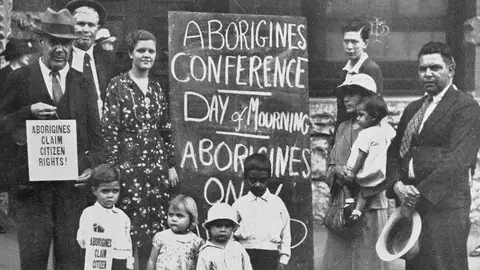NAIDOC Week’s Largely Unknown Radical History

This country’s rich history of First Nations activism and resistance is something that Non-Indigenous Australians have a tendency to know literally nothing about; so to kick off this NAIDOC week this year, we’re thinking about its activist roots.
If you’re a settler like me, it’s likely you don’t even know exactly what NAIDOC actually is, beyond a general celebration of Aboriginal and Torres Strait Island culture.
But NAIDOC week was born from protest. As Wamba Wamba, Yorta Yorta, Dja Dja Wurrung & Dhudhuroa woman Ngarra Murary writes on @IndigenousX: “The roots of NAIDOC Week can be traced back to the 1920s & 30s, when Aboriginal rights groups took formation and staged boycotts and marches on the [Australian] government. Instrumental in these actions were the likes of William Cooper, Jack Patten, Tom Foster and William Ferguson.”
Here’s an (extremely abridged) history of NAIDOC’s political roots, courtesy of naidoc.org.au.
1920s & 1930s:
It was around the 1920s that Aboriginal rights groups boycotted so-called ‘Australia Day’ (January 26) to protest the treatment of First Nations people. Ths movement gained traction via the development of the Australian Aborigines Progressive Association (AAPA) in 1924 and the Australian Aborigines League (AAL) in 1932.
Late 1930s:
In 1938 – while many Australians were celebrating the 150-year anniversary of the First Fleet rolling into town – Sydney’s streets swelled with protesters on so-called ‘Australia Day’, followed by a congress at Australia Hall attended by over a thousand First Nations people. Known as the Day of Mourning, this was actually one of the first civil rights gatherings in the world.
As explained by The Australian Institute of Aboriginal And Torres Strait Islander Studies (AIATSIS), the congress went to the PM at the time with the following resolution: :
‘WE, representing THE ABORIGINES OF AUSTRALIA, assembled in conference at the Australian Hall, Sydney, on the 26th day of January, 1938, this being the 150th Anniversary of the Whiteman's seizure of our country, HEREBY MAKE PROTEST against the callous treatment of our people by the whitemen during the past 150 years, AND WE APPEAL to the Australian nation of today to make new laws for the education and care of Aborigines, we ask for a new policy which will raise our people TO FULL CITIZEN STATUS and EQUALITY WITHIN THE COMMUNITY.’
In 1939, William Cooper asked the National Missionary Council of Australia to make the Day of Mourning a regular national event.
Read more about The Day Of Mourning and its history at AIATSIS.
1940s & 1950s:
From 1940-1955, the Day of Mourning was held annually on the Sunday before so-called
‘Australia day’ and dubbed ‘Aborigines Day.’ [Note: ‘The word ‘Aborigines’ is now an outdated term.]
In 1955, it was then moved to the first Sunday in July, which is when it shifted from being a day of protest to a celebration of Aboriginal culture. This is arguably when The Day Of Mourning started to become more depoliticised for the sake of becoming more palatable to non-Aboriginal Australians.
1956-1990:
The National Aborigines Day Observance Committee (NADOC) was developed with the support of Aboriginal rights groups, Federal and Local governments and church groups.
In 1974, the NADOC committee was exclusively made up of Aboriginal members, and the following year a decision was made that the event should span an entire week, starting from the first Saturday in July.
NADOC asked that National Aborigines Day be made a national public holiday in 1984. This is yet to happen, 37 years later.
1991-Now:
In the ‘90s, NADOC was expanded to recognise Torres Strait Islander people and culture. The committee is now known as the National Aborigines and Islanders Day Observance Committee (NAIDOC). NAIDOC was also extended from a day to a week, and began incorporating themes each year.
Wuthathi man John Paul Janke, who co-hosts The Point on NITV, writes on the importance of properly honouring NAIDOC week’s political roots. “We must never forget that NAIDOC Week is a week borne from a day of protest, a movement towards justice, equality, and freedom and basic human rights.”
And as this year’s NAIDOC theme is ‘Heal Country’, the importance of doing so feels more crucial than ever.
Read more about NAIDOC’s history at naidoc.org.au and follow @IndigenousX on Twitter for NAIDOC week updates and original content from emerging and established First Nations writers all year-round.
To honour the sovereignty of First Nations people, pay the rent.
Written by Reena Gupta, a Naarm-based writer for MTV Australia. Follow her on Twitter @purpletank.





